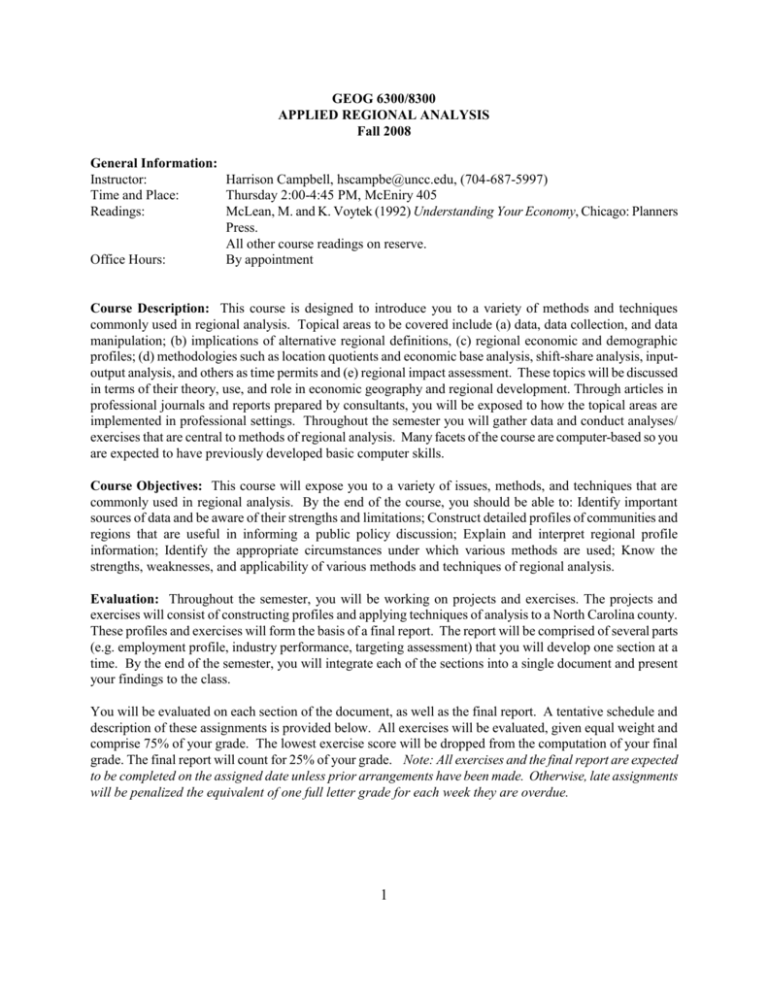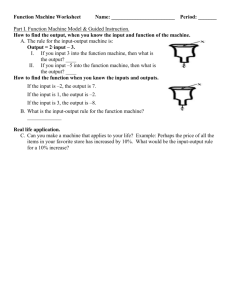GEOG 6300/8300 APPLIED REGIONAL ANALYSIS Fall 2008
advertisement

GEOG 6300/8300 APPLIED REGIONAL ANALYSIS Fall 2008 General Information: Instructor: Harrison Campbell, hscampbe@uncc.edu, (704-687-5997) Time and Place: Thursday 2:00-4:45 PM, McEniry 405 Readings: McLean, M. and K. Voytek (1992) Understanding Your Economy, Chicago: Planners Press. All other course readings on reserve. Office Hours: By appointment Course Description: This course is designed to introduce you to a variety of methods and techniques commonly used in regional analysis. Topical areas to be covered include (a) data, data collection, and data manipulation; (b) implications of alternative regional definitions, (c) regional economic and demographic profiles; (d) methodologies such as location quotients and economic base analysis, shift-share analysis, inputoutput analysis, and others as time permits and (e) regional impact assessment. These topics will be discussed in terms of their theory, use, and role in economic geography and regional development. Through articles in professional journals and reports prepared by consultants, you will be exposed to how the topical areas are implemented in professional settings. Throughout the semester you will gather data and conduct analyses/ exercises that are central to methods of regional analysis. Many facets of the course are computer-based so you are expected to have previously developed basic computer skills. Course Objectives: This course will expose you to a variety of issues, methods, and techniques that are commonly used in regional analysis. By the end of the course, you should be able to: Identify important sources of data and be aware of their strengths and limitations; Construct detailed profiles of communities and regions that are useful in informing a public policy discussion; Explain and interpret regional profile information; Identify the appropriate circumstances under which various methods are used; Know the strengths, weaknesses, and applicability of various methods and techniques of regional analysis. Evaluation: Throughout the semester, you will be working on projects and exercises. The projects and exercises will consist of constructing profiles and applying techniques of analysis to a North Carolina county. These profiles and exercises will form the basis of a final report. The report will be comprised of several parts (e.g. employment profile, industry performance, targeting assessment) that you will develop one section at a time. By the end of the semester, you will integrate each of the sections into a single document and present your findings to the class. You will be evaluated on each section of the document, as well as the final report. A tentative schedule and description of these assignments is provided below. All exercises will be evaluated, given equal weight and comprise 75% of your grade. The lowest exercise score will be dropped from the computation of your final grade. The final report will count for 25% of your grade. Note: All exercises and the final report are expected to be completed on the assigned date unless prior arrangements have been made. Otherwise, late assignments will be penalized the equivalent of one full letter grade for each week they are overdue. 1 Assignments and Exercises: Assignment Date Assigned Due Date Regional Scan Sept. 11 Sept. 18 Population and Labor Force Sept. 18 Sept. 25 Employment Profile Sept. 25 Oct. 2 Income and Earnings Profile Oct. 2 Oct. 9 Shift-Share Analysis Oct. 9 Oct.16 Economic Base Analysis Oct.16 Oct. 23 Input-Output I: Impact AnalysisI Oct. 30 Nov. 6 Input-Output II: Targeting Nov. 6 Nov. 20 Final Report Due Dec. 4 Final Exam Period - Student Presentations Dec 18 Note: You are expected to come to every class prepared for discussion. Course materials should be read before the class in which they are discussed. All UNC Charlotte students have the responsibility to be familiar with and to observe the requirements of The UNC Charlotte Code of Student Academic Integrity (see the Catalog). This Code forbids cheating, fabrication or falsification of information, multiple submission of academic work, plagiarism, abuse of academic materials (such as Library books on reserve), and complicity in academic dishonesty (helping others to violate the Code). Standards of academic integrity will be enforced in this course. A copy of the Code can be obtained from the Dean of Students Office or accessed online at http://www.legal.uncc.edu/policies/ps-105.html . Failure to abide by the code could result in failure of this course. 2 Geography 6300/8300: Applied Regional Analysis Note: + indicates required reading for PhD students Date 8/28 Topic I. INTRODUCTION TO REGIONAL ANALYSIS a. Introduction and Course Overview McLean, M. and K. Voytek (1992) AOverview of Strategic Planning,@ Chapter 1 in Understanding Your Economy, Chicago: American Planning Association, pp. 1-7. Richardson, H. (1978) AIntroduction,@ Chapter 1 in Regional Economics, Urbana: University of Illinois Press, pp. 17-37. (especially 17-29) Levitan, D. (1993) AHow to Read the Economy: A Primer,@ Government Finance Review, April. 9/4 b. Regions in Analysis Campbell, H. and A. Stuart (2003) Situation Analysis of the Future Forward Study Region, Report prepared for Future Forward Leadership Committee, Comprehensive Economic Development Strategy, 10th and 11th Congressional Districts, North Carolina, p. 1-11. Available electronically at http://www.future-forward.net/pdf/FinalSITReport6.2.pdf or http://www.future-forward.net (Research and Reports). AKA: Hickory CEDS Study. AAbout Metropolitan Areas,@ U.S. Census Bureau, Available electronically at http://www.census.gov/population/www/estimates/aboutmetro.html AStandards for Defining Metropolitan and Micropolitan Areas,@ U.S. Census Bureau, Available electronically at http://www.whitehouse.gov/omb/fedreg/metroareas122700.pdf see especially pp. 82228, 82236-82238. Also summarized at http://www.gadata.org/information_services/Census_Info/Standars%20for%20Defining%20MSA. htm “Current Lists of Metropolitan and Micropolitan Areas,” see http://www.census.gov/population/www/estimates/metrodef.html Note: this link contains both current and historical metro definitions. It is just for your reference. + Management and Budget Office (1998) AMetropolitan and Nonmetropolitan Areas: Definition Standards Review and Alternative Approaches,@ Federal Register, December 21, 1998, pp. 70525-70561. PDF available at http://frwebgate.access.gpo.gov/cgi-bin/getdoc.cgi?dbname=1998_register&docid=98-33676filed.pdf 9/11 c. Data Sources, Classification and Manipulation McLean, M. and K. Voytek (1992) AStructuring the Analysis: Concepts and Issues,@and AAssessing Economic Performance and Condition,@ Chapters 2 & 3 (part) in Understanding Your Economy, Chicago: American Planning Association, pp. 9-29; 31-36. Cortright, J. and A. Reamer (1998) Socioeconomic Data for Understanding Your Regional Economy: A User=s Guide, Economic Development Administration, U.S. Department of Commerce. Available electronically at 3 http://www.eda.gov/ImageCache/EDAPublic/documents/pdfdocs/1g3_5f12_5fsocio_2epdf/v1/1g3 _5f12_5fsocio.pdf 9/18 II. REGIONAL PROFILES a. Population and Labor Force McLean, M. and K. Voytek (1992) AAssessing Economic Performance and Condition,@ AProfiling Local Human Resources,@AEvaluating Local Growth Prospects,@ and AProfiling Local Human Resources,@ Chapters 3, 5 and 6 in Understanding Your Economy, Chicago: Planners Press, pp. 40-42; 99-103; 106-116; skim 116-131. Hickory CEDS Study, p. 12-19; 25-28. Available electronically at http://www.future-forward.net/pdf/FinalSITReport6.2.pdf or http://www.future-forward.net (Research and Reports). + Gibson, L. (1987) ALabor Force Surveys and the Economic Development Program,@ Economic Development Review, Summer. 9/25 b. Employment and Location Quotients McLean, M. and K. Voytek (1992) AAssessing Economic Performance and Condition,@ and AProfiling Local Human Resources,@ Chapters 3 & 4 in Understanding Your Economy, Chicago: Planners Press, pp. 31-39; 51-66. Hickory CEDS Study. p. 29-46. Available electronically at http://www.future-forward.net/pdf/FinalSITReport6.2.pdf or http://www.future-forward.net (Research and Reports). + Miller, M., L. Gibson, and N.G. Wright (1991) ALocation Quotient: A Basic Tool for Economic Development Analysis@ Economic Development Review, 9(2). 10/2 c. Earnings and Income McLean, M. and K. Voytek (1992) AAssessing Economic Performance and Condition,@ Chapter 3 and AProfiling Local Human Resources,@ Chapter 4 in Understanding Your Economy, Chicago: Planners Press, pp. 42-49; 51-58. Hickory CEDS Study. p. 20-24. Available electronically at http://www.future-forward.net/pdf/FinalSITReport6.2.pdf or http://www.future-forward.net (Research and Reports). 10/9 III. ANALYTICAL TECHNIQUES a. Shift-Share Analysis McLean, M. and K. Voytek (1992) AAnalyzing the Structure and Dynamics of a Local Economy,@ Chapter 4 in Understanding Your Economy, Chicago: Planners Press, pp. 67-74. Stevens, B. and C. Moore (1980) AA Critical Review of the Literature on Shift-Share as a Forecasting Technique,@ Journal of Regional Science, 20(4). 4 + Barff, R. and P. Knight (1988) ADynamic Shift-Share Analysis,@ Growth and Change, Spring, pp. 1-10. + Buck, T. (1970) AShift-Share Analysis -- A Guide to Regional Policy?,@ Regional Studies, 4, pp. 445-450. + Fothergill, S. and G. Gudgin (1979) AIn Defense of Shift-Share,@ Urban Studies, 16, pp. 309319. 10/16 b. Economic Base Analysis McLean, M. and K. Voytek (1992) AAnalyzing the Structure and Dynamics of a Local Economy,@ Chapter 4 in Understanding Your Economy, Chicago: American Planners Press, pp. 51-66. Isserman, A. (1980) "Alternative Economic Base Bifurcation Techniques: Theory, Implementation, and Results," in Pleeter (ed.) Economic Impact Analysis: Methodology and Applications, Martinus Nijhoff Pub, pp. 32-53. Campbell, H.S. (2003) AUnearned Income and Local Employment Growth in North Carolina: An Economic Base Analysis, Southeastern Geographer, 43(1): 89-103. + Pfister, R. (1980) AThe Minimum Requirements Technique of Estimating Exports: A Further Evaluation,@ in Pleeter (ed.) Economic Impact Analysis: Methodology and Applications, Martinus Nijhoff Pub, pp. 54-67. + Tiebout, C. (1962) The Community Economic Base Study, New York: The Committee for Economic Development. + Biles, J. (2003) “Using Spatial Econometric Techniques to Estimate Spatial Multipliers,” The Review of Regional Studies, 33(2): 121-141. 10/23 c. Input-Output I: Model Basics Hewings, G.J.D. (1985) Regional Input-Output Analysis, Scientific Geography Series, Vol 6, Grant Ian Thrall, ed., Beverly Hills: SAGE, p. 9-37. PDF available at: http://www.rri.wvu.edu/WebBook/Scientific%20Geography%20Series%20PDF/6_Regional%20In put-Output%20Analysis.pdf Hastings, S. and S. Brucker. (1993) "An Introduction to Regional Input-Output Analysis" in Microcomputer-based Input-Output Modeling, D. Otto and T. Johnson, ed., Boulder, CO: Westfiew Press. +Babcock, M. (1993) "A Survey Approach to Developing and I/O Model" in MicrocomputerBased Input-Output Modeling, D. Otto and T. Johnson, ed., Boulder, CO: Westview Press, pp. 5769 +Braschler, C. and G. Devino. (1993) "Nonsurvey Approach to I/O Modeling" in Microcomputer Based Input-Output Modeling, D. Otto and T. Johnson, ed., Boulder, CO: Westview Press, 70-78. 5 + Round, J. (1983) "Nonsurvey Techniques: A Critical Review of the Theory and Evidence," International Regional Science Review 8: 189-212. + Romanoff, E. (1974) “The Economic Base Model: A Very Special Case of Input-Output Analysis,@ Journal of Regional Science 14: 121-130. + Miernyk, W. (1967) AThe Rudiments of Input-Output Mathematics,@ in The Elements of InputOutput Analysis, New York: Random House, p. 128-151. PDF available at: http://www.rri.wvu.edu/WebBook/Miernykweb/new/chapterseven.pdf 10/30 d. Input-Output II: Impact Assessment Hewings, G.J.D. (1985) Regional Input-Output Analysis, Scientific Geography Series, Vol 6, Grant Ian Thrall, ed., Beverly Hills: SAGE, p. 37-57. PDF available at: http://www.rri.wvu.edu/WebBook/Scientific%20Geography%20Series%20PDF/6_Regional%20In put-Output%20Analysis.pdf Schaffer, W. (1980) "The Role of Input-Output Models in Regional Impact Analysis," in Pleeter (ed.) Economic Impact Analysis: Methodology and Applications, Martinus Nijhoff Pub., pp. 156167. Henry, M. and T. Johnson (1993) "Cautions in Using I/O Models," in Microcomputer-Based Input-Output Modeling, in D. Otto and T. Johnson ed., Boulder, CO: Westview Press, pp. 28-46 Figueroa, E. and R. Woods (2007) AIndustry Output and Employment Projections to 2016,@ Monthly Labor Review, November 2007, 53-85. Available electronically at http://www.mwcog.org/uploads/committee-documents/lF5fXl1Y20080103100121.pdf + Stevens, B.H. and M.L. Lahr. (1988) "Regional Multipliers: Definition, Measurement, and Application", Economic Development Quarterly, 2(1), pp. 88-96. + Miernyk, W. (1967) AApplications of Input-Output Analysis,@ in The Elements of Input-Output Analysis, New York: Random House, p. 31-57; esp. 42-55. Also available at: http://www.rri.wvu.edu/WebBook/Miernykweb/new/chapterthree.htm + Coughlin, C. and Mandelbaum, T. (1991) AA Consumers Guide to Regional Economic Multipliers,@ Federal Reserve Bank of St. Louis. 11/611/13 e. Input-Output III: Industry Targeting Muench, D. and S. Deller (2001) AThe Economic Structure of the Fox Valley: A Study of Economic Opportunity,@ Staff Paper 444, Department of Agricultural & Applied Economics, University of Wisconsin: Madison. Available electronically at http://www.aae.wisc.edu/pubs/sps/pdf/stpap444.pdf Hickory CEDS Study: p. 47-70 Available electronically at http://www.future-forward.net/pdf/FinalSITReport6.2.pdf 6 or http://www.future-forward.net (Research and Reports). Figueroa, E. and R. Woods (2007) AIndustry Output and Employment Projections to 2016,@ Monthly Labor Review, November 2007, 53-85. Available electronically at http://www.mwcog.org/uploads/committee-documents/lF5fXl1Y20080103100121.pdf 11/20 IV. CONCLUSION AND WRAP-UP OPEN: Debriefing / Lab Time 11/27 No Class – Thanksgiving Break 12/4 Final Report Due 12/18 Final Exam Period - Student Presentations 7







